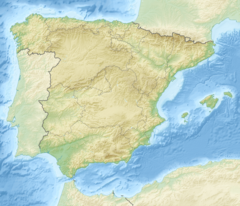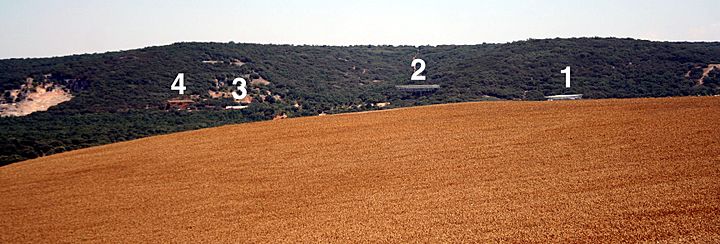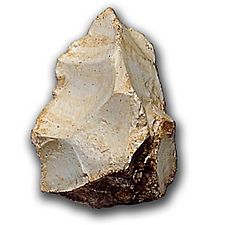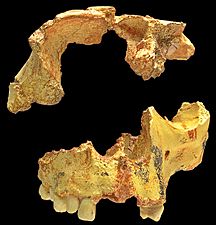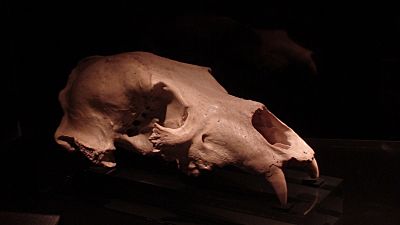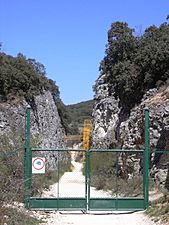Atapuerca Mountains facts for kids
|
Sierra de Atapuerca
|
|

Atapuerca Mountains panorama
|
|
| Location | near Atapuerca, Ibeas de Juarros |
|---|---|
| Region | Burgos, Castile and León |
| Coordinates | 42°22′0″N 3°31′20″W / 42.36667°N 3.52222°W |
| History | |
| Periods | Paleolithic |
| Associated with | Homo antecessor, Homo heidelbergensis, Homo neanderthalensis |
| Site notes | |
| Excavation dates | since 1964 |
| Archaeologists | Francisco Jordá Cerdá |
| Website | http://www.atapuerca.org/ |
| UNESCO World Heritage Site | |
| Official name | Archaeological Site of Atapuerca |
| Criteria | Cultural: (iii)(v) |
| Inscription | 2000 (24th Session) |
| Area | 284.119 ha (702.07 acres) |
The Atapuerca Mountains (Spanish: Sierra de Atapuerca) are a group of hills in northern Spain. They are found near the village of Atapuerca in the province of Burgos. This area is part of the Castile and León region.
Scientists have found many important fossils and stone tools here. These finds show that some of the earliest known humans lived in Western Europe. The Atapuerca Mountains were a popular home for early human groups. These included Homo erectus, Homo antecessor, Homo heidelbergensis, and Homo neanderthalensis. The oldest human remains found here are between 1.2 million and 630,000 years old.
The Archaeological site of Atapuerca is so important that it is a World Heritage Site. You can see some of the amazing discoveries at the Museum of Human Evolution in Burgos.
Contents
Where are the Atapuerca Mountains?
The Atapuerca Mountains are a range of small hills. They are about 1,080 meters (3,540 feet) above sea level. These hills are located in the northeast part of the Douro river basin. They are south of the Cantabrian Mountains in northern Spain.
The mountains are also next to the Bureba corridor. This is a mountain pass that connects the Ebro river valley with the Mediterranean Sea. It also links to the Duero river basin. This area is special because it brings together different natural environments. This means it has many types of plants and animals.
This mountain pass was once a road built by the Romans. It was also part of the Saint James pilgrimage route. Today, major highways run through it. The mountains' location was very good for early humans. It helped them live there for a long time.
Ancient Animals Found Here
In 2008, scientists found a new type of shrew in the Atapuerca caves. This shrew lived during the Pleistocene Ice Age. Before this discovery, researchers thought all shrew fossils here were of a different type. But new studies showed it was a unique Asian type. It is called Dolinasorex glyphodon. This is the oldest known shrew of its kind in Spain.
The Archaeological Site
The archaeological site of Atapuerca is very important. Because of its value, UNESCO named it a World Heritage Site in 2000. This means it is protected for everyone to learn from.
How the Site Changed the Area
The archaeological site has brought many changes to the local area. It has helped the town grow in many ways. More jobs are now related to tourism. About 15% of the working people have jobs linked to the site. This has helped the population grow and become younger. The average age in the area is now 42 years old.
Gallery
-
Homo antecessor, incomplete skull found in "Gran Dolina", Atapuerca
See also
 In Spanish: Sierra de Atapuerca para niños
In Spanish: Sierra de Atapuerca para niños
- Devil's Tower (Gibraltar)
- Forbes' Quarry
- List of fossil sites (with link directory)
- List of human evolution fossils
- Orce
- Pierolapithecus
- Sidrón Cave
- Sima de las Palomas




